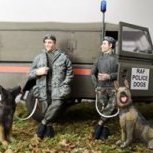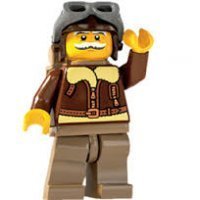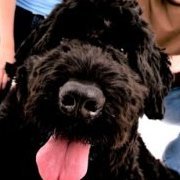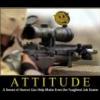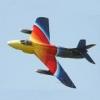Search the Community
Showing results for tags 'Resin'.
-
Time for a new build. Cropdusting in the 1950's in Australia (& NZ) largely consisted of ex military aircraft - lots of Tiger Moths, and conversion of others such as the CAC Wackett (into the Cropmaster), and the CAC Wirraway (into the Ceres). The Ceres, whilst based on Wirraway 'bits' had a myriad of changes - all aimed to improve low and slow performance. New wing centre section and longer wings, leading edge slat, larger slotted flaps, new hopper and higher mounted cockpit position. Etc! As a taster - here's a Geoff Goodall image of a Ceres in operation on a fishlings drop[!] (VH-CEX in Victoria in 1961). From a modelling perspective - there have been a number of kits of the CAC Wirraway across various scales (the Special Hobby 1/48 was a most welcome addition) - and a handful of modellers have undertaken the Ceres conversion. I've previously done a 1/48 conversion. A relatively recent release (2020) is a delicate 1/72 resin kit from Lift Here models of Serbia. Google says it's still available from Aviation Megastore, and I guess other suppliers may have stock. The boxtop looks like this And I HAVE to give a plug to the definitive tome on the Ceres - which is the book from Derek Buckmaster released in 2017. You'll find the book at the URL listed on the box top (top right) - and the book instigated the model. Not often a model company would have THIS sort of reference available for tooling their kit. Note I have no relationship with either Lift Here or Derek (although Derek is known to frequent Britmodeller as @Derek_B ). So what's inside? The main parts are packed in a 'split-sealed' plastic bag - which successfully stops the big bits rattling round with the little bits. - there are TWO vacform canopies provided and what serves as a canopy master providing packing to stop any crushing. - Instructions are simplistic, but sufficient. Every part is clearly identified and named. - and a front 3/4 view of the aircraft indicates positioning of parts. - oh, and a nice set of decals for one colour scheme (per the box art) of VH-SSZ Certainly a case of 'some modelling skills an advantage' for this one - but I've seen worse instructions from mainstream manufacturers. Below is a closer shot of the main fuse and (single piece) wing - very delicate detailing - fine resin moulding - fuse resin is as thin as you'd see in an injection moulded kit (and light in weight accordingly). - there's not a pin hole in sight. The dots you can see around the nose are the fasteners for various panels - wings are single piece but have a beautifully sharp trailing edge (better than you get from many an injection moulded kit) - and everything matches the plans in Derek's book impeccably. This is going to be fun... First task is a bath in strong dishwashing detergent. It's recommended in the instructions and an early dry fit with tamiya tape (which wouldn't stick!) proved there was some mould release agent that needed releasing... And here are the parts laid out more carefully. Everything looks entirely usable. The only things I might look at replacing are top right which includes - rollover framing for cockpit. - instrument panel and tailwheel - rudder pedals, shock absorbers etc. It's all there... That'll do for an introduction. - I haven't settled on a colour scheme yet (might well be some surgery involved if I decide on the 2-seater version). - there are some really nice schemes on this from operations in Australia and NZ. - and there's a couple in museums, and one or two still flying.
- 40 replies
-
- 23
-

-
Ok the idea for this build is a bit of a mash up of a couple of builds I have wanted to do, but didn’t the time or the motivation for at the time. One has been running around in one form or another in my mind for quite a while now. I have come close a couple of times to starting it, (a Ho-229 was to be the base for one) and I sort of did with the Turbo-Prop Arado, but it still wasn’t quite what I had in mind. I have two similar projects on the go but they're on the back burner for a bit. The second was that I have a Planet Models Ju-388J nightfighter (Jumo 213 version) sitting in the stash that I have been dying to build and have never had the excuse to. So after seeing the Ju-88 STGB I finally had the idea of how to killer two birds with one stone and bring these two ideas together! So the plan is…… If the war had stretched into 1946 we would have seen some interesting aircraft and technologies in service, especially so with radar technology advancing as quick as is was. By the end of the war we were already seeing the next generation of radar systems which operated in the Centimetre band, like the RAF’s H2S and US H2X radars and the German FuG-240 (Berlin) & FuG-244 (Bremen) units. A few of the Ju-88’s were fitted with the FuG-240 and it was found they recovered their original speed which had been lost with the earlier radar units and their large antennas/antlers! It would have been only to be a matter of time before the use of the FuG-240 (and later versions) would have been more widespread, with it being fitted to newer aircraft models as they became available. With the venerable Ju-88 reaching it’s peak in the Ju-388 family this aircraft would have been a prime candidate for the new radar system. Well that’s the plan, chop the nose off a 388 and fit a new nose, simple really, but……….. I want it to be as believable as possible and not too whiffy which will make it a bit harder. So this will be the base, Planet Models Ju-388J-3 with Jumo 213 engines, of cause I reserve the right to add lots of other stuff as I go along, it wouldn’t a normal build if I didn’t throw in heaps of extras! The 388 is actually quite a nice model the only thing that may give me issues is the wings, they are very slightly warped and getting the dihedral right will be fun! The nose is just a resin cast of the long radome version, it looks a bit better in my opinion than the shorter version. Well best to start by cutting off the nose, luckily there is a very convenient panel line to follow for this. Strangely enough this happens to be almost perfectly round which will make life much easier as we go to fit the nose. Ok first fit, it doesn’t look all the great, I’ll need to move it forward a bit. That’s looking a bit better, so I’m going to have to add a bit to get the profiles right, I have a plan for that! First I’ll make a ring using plastic card, working with plastic will make this part so much easier! Next to fill the gap I’m going to use plastic strip like so. I just keep adding rings till I get the right diameter. Then add a disk at the back the size I require and the first part is done, only a small amount of filler required for shaping. Ignoring the joint gap for the moment I now have to decide how I want the new nose to sit, sort of inline with the horizontal axis or a bit dropped down? I like the inline one as it looks good, but I have to remember the flying attitude of the 388 (and 88 for that matter) was slightly nose up, they didn’t fly truly level! So I may need to have it slightly drooped down so the antenna face would be lined up to the vertical axis. Have a look at how the antennas were mounted on 88’s and you’ll see what I mean. Well I’ve made a start, there’s only a couple of hours work (I needed a brake from the Ta-152 as I was getting annoyed with it!) and the project is a goer. I’ve actually done the filling of the nose now as well and it’s looking good! This won’t be a full time project, just something to work on when my other builds frustrate me and I need a break from them. I can’t promise I’ll be finished by Xmas either as I’m bound to do other mods on this as I go along. This should be an interesting build!
- 14 replies
-
- 11
-

-
While waiting for suitable weather conditions to paint my entry in another GB (it's cold and humid), I was seduced by this excellent GB topic. Will you have me in your ranks? Drawn like a moth to light, I thought I might have a crack at my first resin kit, the Commonwealth Aircraft CA-15 by Planet Models. Looks great in the box, I do like a low parts count and ...oohah... the parts are SOLID. Let's see how it builds. I'm claiming a tenuous connection with this aircraft. It was designed and constructed at Fishermans Bend, downriver from my home in Melbourne. In addition, Dad worked as an engineer at Commonwealth Aircraft Corporation, albeit not in the 1940s. I guess the brand loyalty lingers regardless 🤓 I've known about this aircraft since early teenage years when I worked as a volunteer with the Australian Aircraft Restoration Group. I somewhat dismissively thought of it as a souped-up Mustang. Wrong! It is primarily influenced by the Focke-Wulf Fw190 and was initially designed around the massive radial engines thought to be available in 1943. CAC didn't begin assembling kit Mustangs until early 1944 and commenced manufacture in late 1944.
- 12 replies
-
- 11
-

-
- Planet Models
- Resin
-
(and 1 more)
Tagged with:
-
Good day, colleagues and sympathizers. Today I want to present to you for inspection a fresh model from SPM - truck AMO F-15. The second in the epoxy recently. At one time, I missed a model from the company OtVinta and this time I decided to buy it. A lot has been said about the prototype, if you search. In short, a one-and-a-half-ton truck, the first serial in the Soviet Union. As with many cars in the USSR - in the girlhood it was a Fiat 15 ter, somewhat redesigned as a result by our engineers to match the "beautiful" roads) An overview of the details of the model I posted here not so long ago -; https://karopka.ru/community/user/24492 /?MODEL=631069 The box gives a choice of 3 assembly options, all for the early production period. Assembly - everything is easy to assemble, the parts practically do not require fitting. Olives are thin, neat, I got them without defects. There are several nuances in the correspondence of the model to the prototype. The absence of a window in the tent, the absence of a second handle on the right (the handbrake and gearshift were still both outside). I didn't dig deeper into the match, but judging by the photos, people who are "sick" with this will have questions) As I wrote above, there are 3 model assembly options in the set: 1. The earliest "First AMO" 2. The next issue, 1925 (if I found the info correctly) 3. Differs from the second variant by the stamp of the hood sidewalls. It's generally difficult here, but there are photos of such cars. I chose the second option. A car that participated in the 1925 Leningrad-Moscow-Kursk motor rally (for trucks). It is noteworthy that both AMOS from the participants of the run came taking 1st and 2nd place. I don't want to make a very clean or very dirty car, so it turned out something in between. We will assume that they have recently left) Coloring - traditionally AKAN, a little Gunze (supermetallics top). AK oil, pigments - strategic reserves of masterpigment) Enjoy watching, thank you for your attention) Good day, colleagues and sympathizers. Today I want to present to you for inspection a fresh model from SPM - truck AMO F-15. The second in the epoxy recently. At one time, I missed a model from the company OTVINT and this time I decided to buy it. A lot has been said about the prototype, if you search. In short, a one-and-a-half-ton truck, the first serial in the Soviet Union. As with many cars in the USSR - in the girlhood it was a Fiat 15 ter, somewhat redesigned as a result by our engineers to match the "beautiful" roads) An overview of the details of the model I posted here not so long ago -> https://karopka.ru/community/user/24492 /?MODEL=631069 The box gives a choice of 3 assembly options, all for the early production period. Assembly - everything is easy to assemble, the parts practically do not require fitting. Olives are thin, neat, I got them without defects. There are several nuances in the correspondence of the model to the prototype. The absence of a window in the tent, the absence of a second handle on the right (the handbrake and gearshift were still both outside). I didn't dig deeper into the match, but judging by the photos, people who are "sick" with this will have questions) As I wrote above, there are 3 model assembly options in the set: 1. The earliest "First AMO" 2. The next issue, 1925 (if I found the info correctly) 3. Differs from the second variant by the stamp of the hood sidewalls. It's generally difficult here, but there are photos of such cars. I chose the second option. A car that participated in the 1925 Leningrad-Moscow-Kursk motor rally (for trucks). It is noteworthy that both AMOS from the participants of the run came taking 1st and 2nd place. I don't want to make a very clean or very dirty car, so it turned out something in between. We will assume that they have recently left) Coloring - traditionally AKAN, a little Hansa (supermetallics top). AK oil, pigments - strategic reserves of masterpigment) Enjoy watching, thank you for your attention)
-
This a model of the Saunders Roe SR-53 mixed jet and rocket aircraft from the recent cast resin 1/48 kit. Something many of us thought was in RAF service in the 1960's thanks to Airfix releasing their kit in the 1950's. Well that was in 1/72 but we had to wait another 60 years for a kit in 1/48. The real aircraft survives at RAF Cosford. So here it is, my model of the SR-53, a key British Aircraft of the 1950's. I have never heard of the manufacturer before, 'Simian Stuff', but first impressions are good. The kit comes in a stout box with the resin parts sealed in plastic. The main parts are individually sealed with the smaller parts in groups. A good, strong looking undercarriage and nose weight are cast in white metal. Detail in the cockpit and wheel wells is excellent and the nose probe is fine and beautiful. I replaced mine with a needle set in Milliput though as I cannot trust myself not to knock the resin one off. There are 2 vacformed canopies and a set of decals for both planned aircraft. These have no white printed, which is fine on a white plane but will be problematic if building an in service scheme! The kit has what appears to be the best set of instructions for a resin / limited run kit so far Thanks to @BritJet. Heres whats in the box There are some good alignment tabs on this kit but a jig is still a good idea to get everything square Some filler required as well as a bit of fettling but less than most resin kits. Heres the finished model Who wouldn?t want red missiles with blue fins? Yes, well maybe as it was in the 1950's! This was a great little kit and cudos to Simian Stuff/ Herritage Aviation for making it. A few minor improvements could be made but right now its already very good. This was built in the Group build section of Britmodeller under the 'Experimental, Prototypes and Special Schemes Mega Group Build' Build Thread here Colin
-
This Group Build covers my main area of modelling interest so I can enter numerous models from the stash. I have decided to build the SR-53 as it is a key British Aircraft and is quite a recent kit. I have never heard of the manufacturer before, 'Simian Stuff', but first impressions are good. The real aircraft survives at RAF Cosford. The kit comes in a stout box with the resin parts sealed in plastic. The main parts are individually sealed with the smaller parts in groups. A good, strong looking undercarriage and nose weight are cast in white metal. Detail in the cockpit and wheel wells is excellent and the nose probe looks fine and beautiful. It will have to be replaced though as I cannot trust myself not to knock it off. There are 2 vacformed canopies and a set of decals for both planned aircraft. These appear to have no white printed so I'll have to remember to mask the base coat! The kit has what appears to be the best set of instructions for a resin / limited run kit so far so I'm hopeful of an easy build. So here's what you get. We have a good rendition of the jet compressor and some great cockpit detailing on both halves. Looking forward to making a start soon as my F15 for the Eagle GB is nearly ready for a coat of paint.
- 37 replies
-
- 22
-

-

-
Well it’s finally done. It’s taken a while for me , mostly reshaping and rescribing the head. The 3D printed canopy is beautiful too. I have built a lot of Y-wings in my time , but this colour scheme is my all time favourite. The model is old and not accurate to any particular y-wing studio model , but I did the colour scheme as close as I could to Gold 5. There’s been times when I have hated this model , and it spent a few days on eBay unfinished , but I’m glad I saw it through. It was good to do an old skool resin kit again.
-
Lets see if I can visit some more of my "X's. In this corner we have.... Collect-Aire's 1/48 Bell X-2. I'm not sure how much extra added detail will be achieved with this build, but is a Collect-Aire kit and that means some rein wrangling will be necessary. My little X-4 that I just finished was unique in that the resin had NO pin holes in it! I don't think I'll as lucky this time. But no matter a good time will be had by all. No matter what transpires, a good time will be had by all. Unless it don't, then the sloppy beat downs will commence until morale improve But as always all comments, suggestions, musings and cheer leading are always welcome. So let's see what my X's have provided me today shall we?
- 28 replies
-
- 7
-

-
- 1/48 Collect-Aire
- Bell X-2
-
(and 1 more)
Tagged with:
-
The Boeing YAL-1 was converted from a freighter 747-400F and used to test laser weapons that could destroy incoming missiles. This was done in the years 2001 to 2012. The aircraft was scrapped after the end of the test flights. I have built this model using the kit by Anigrand. They produce resin kits of very rare aircraft. The fuselage consists of two halfs and is hollow as it would be as a normal plastic kit. The engravings are very very sharp but way too deep. I have tried to fill most of them but it was very hard to achieve a nice result. I have added the fuselage strengthening stripes around the rear freight door and used spare decals to show the door. As the landing gear was not very convincing to me I decided to display the aircraft in flight. Meanwhile the model had got the nickname "Ed" for obvious reasons. Ed was put into storage in the basement and Joe, a friend and fellow modeller kept asking what had happened to Ed. So, Finally I found the motivation to finish him and display Ed in Telford next to the An-225. Would I build another YAL-1 by Anigrand? No, it is very expensive and of course very big. But bext I would consider using only parts of the kit and parts from a Revell -400 and 747-8F. That would definitely make a better result. Again...very expensive and a lot of work. But it is unique... Being a resin kit, it could be expected that at least one part would be warped. Here it is the left wing that points downward but should of course be bent upwards. A treatment with heat helped only for a short time. So this flaw has to be accepted. I hope you that you enjoy the fotos inspite of this flaw. greetings from Germany and see you in Telford! Norbert
-
This is my attempt at the Mig Productions burnt out saloon car, that will form part of an ongoing diorama. I think the car is based on a 60's Datsun Bluebird although could be any generic model of that time really. The kit is all resin and has some very large casting blocks, along with some very fiddly wire for the seat frames that need to be made with the included jig. The seat frames are supposed to be soldered together I think, but my soldering skills are not up to that level of detail, so I twisted and superglued them instead. They seem to have turned out ok when painted and to be honest are hardly visible sadly. Paint is AK acrylics, AK chipping fluid, AK rusted deposits weathering set and some oils.
- 11 replies
-
- 24
-

-
G'day everyone. The types built at Fishermens Bend continue to fascinate me. However, many of the more esoteric prototypes have never been tooled in a high-quality injection molded kit. Crazy, right? So this has lead me down the path of resin. I try to model the prototypes where possible, so at some point I'll be shortening the tail of a Nomad, grafting a Gypsy Major onto the nose of a Wackett and removing the cowling from a Ceres. However, I had an idea. Maybe I should try a resin kit straight out of the box before I go hacking up some perfectly good (and somewhat expensive) kits. This is where the CA-15 comes in. Every kit's a model of the prototype if they only built 1! I had the option of the CMR or Kora kits. I'd head bad things about the CMR one, but couldn't find any reviews or builds of the Kora. Photos of the parts showd that it had nice surface detail though, so I got myself a copy of it. I'm not completely new to resin (having built a Beaufort Mk.V with the High Planes conversion), so I knew to be careful when cutting and sanding the parts. Lots of slow, careful sawing under a running tap in the laundry, and some sanding in similar circumstances, left me here. Everything needed to build the cockpit and close up the fuselage is separated from the casting blocks. Clean up wasn't too bad, and the surface detail does indeed look nice. The kit also comes with a few photo etch pieces. After a bath in soapy water, I cracked out the super glue and put together the cockpit pieces. These went together without issue, but a test fit suggests I may need to trim the corners of the rear bulkhead. And this is how far I got before the notion of building it without any modifications ended. I looked at the fuselage pieces, and just couldn't make myself be happy with the outlet duct form the radiator....mainly because there isn't one. Just a flat plate, which I was presumably meant to paint black. So, out came the saw again. It actually wasn't too hard to cut along the existing contours to achieve this result. I've since cut out the other side too. Now, on to some paint. I hit the interior of the fuselage, and the assembled cockpit, with some black Mr. Surfacer. Straight from a can, because I can do it outside and not have to ever use laquer thinners in my airbrush indoors. Despite the high volume of paint, it settled into the details well. I also sprayed the photoetch sprue at the time. At this point, I had to stop work on the cockpit. I've got a delivery of modelling goodies arriving tomorrow that includes some paint for the lurid RAAF interior green. I could mix it myself, but I just can't motivate myself to do it when I know I'll have the right stuff arriving tomorrow (which is also going to go inside a CAC Mustang, possibly, pending research of colours of the early kit-built Mustangs). But, I wasn't quite done. I found some clear plastic lying around and glued the paper instruments to it, using Micro Scale Industries Micro Crystal Clear. It looks a bit rudimentary like that, but after attaching it to the photo-etch panel, it looks pretty great! The panel was dry brushed with dark grey and had some entirely fictional splashes of colour added to make it stand out a bit more once the canopy is on. Trust me, it looks a lot better than my phone camera under indoor lighting could convey. The clear plastic worked well, the instruments reflect light at the right angles, and they appear to have depth. So that's where I'm up too. I hope to get the cockpit pretty much done tomorrow. I'm stuck at home with a (thankfully mild) case of covid for the next week. I'm luck in that it's bad enough not to go to work, but not to bad to sit at the workbench. Fingers crossed it stays that way!
- 11 replies
-
- 6
-

-
RAF Houchin 25K VA Ground Power Unit (229732) 1:32 VideoAviation To some modellers the name of this essential piece of aircraft ground-handling kit might still garner a response such as "A what now?", but without these unassuming boxes that contain diesel or petrol engines to generate ground power for aircraft when their engines are off. Technicians and crews couldn't work on the systems without lighting up the engines so that the aircraft could have electrical power, which is expensive and dangerous if you’re not paying attention. Whenever an aircraft was preparing for flight, or engaged in maintenance, there would always be one of these nearby chugging away and generating the power needed to run the systems, plus a lot less pollution than the gas-guzzling jet engines otherwise would. This particular type of unit was used at the height of the Cold War to power the Lightning, Hunter, Phantom, Buccaneer, Harrier, Jaguar and Sea King to name a few, supplying them with 28v DC and 200v AC on two separate connections. It lapsed into obsolescence which the introduction of the Tornado which needed more power for its advanced systems, and the retirement of the older aircraft from the RAF's fleet. There are still some in service with conservation groups that have suitable aircraft in their hangars. The Kit The resin set is already available in 1:72 and 1:48 and now is out for the large-scale modeller. It arrives in a sturdy cardboard box, with the bright yellowy cream-coloured parts in Ziploc bags swaddled in bubble wrap. The instruction sheet also helps keep the parts safe, and details construction in an isometric format. Because this is larger scale, it comes with more detail than its smaller scale predecessors. This set includes seventeen resin parts, eight 3D Printed parts in grey resin, four clear resin parts, a length of flexible black tubing, plus a small sheet of decals with yellow stripes and data plates. The main body is a large hollow part to which you add the top panel with various circular caps, the bottom surface with the pivoting hole and guide arc, plus the radiator on the front of the device. The two axles are made up on palettes and are supported by leaf-springs, the front axle also having a peg on which it pivots. The front axle slots into the hole in the underside, while the rear slides under the back with a bumper/fender on the reverse. A 3D exhaust/muffler is glued into a hole in the underside, and more 3D parts are attached to the back for the towing hitch and filler tube. At the rear the control panel is inserted into a recess and is either enclosed by the two doors if you don’t want to paint the details, or you can leave them open to show off your hard work. The top of the unit is dotted with clear resin parts on the raised circular areas, and 3D lifting eyes are glued into little holes in the corners. The towing A-frame has a 3D tripod support fixed underneath and another 3D hitch on top, after which it is glued into the brackets on the front of the forward axle, with a narrow cable running to it from under the unit, which you’ll have to find from your own supplies. The thick AC/DC cable is made from the flexible hose, adding a 3D plug to the end. Markings The instructions provide a painting guide to the details, and advise you to look at their site for some painting assistance, which gives a choice of yellow, tan or green for the body, depending on whether you are modelling an early or late unit respectively. The decals include four yellow warning stripes, plus a pair of unit numbers for the top of each end. You can see the reference photos by clicking on the link below. Conclusion A great addition to any ground-handling diorama that won't tax your skills to complete, but will add some interest to your work. Highly recommended. Review sample courtesy of
-
Hello everyone! Here is my latest kit which has been almost three months in the making. It's Anigrand Craftswork's resin 1:144 Focke-Wulf Fw 200C-4/U2. It represents CE+IC (0138), of the Fliegerstaffel des Führers (F.d.F.), on the Eastern front, in late 1942. The Fliegerstaffel des Führers was a small fleet of transport aircraft for German government officials and high ranking command officers. It was established in the mid-1930s mostly with Ju 52s and later used Fw 200s and at least one Ju 290. Hitler, Himmler and Karl Dönitz each had a personal Fw 200. In fact, Hitler, was the first head of state in the world to have an official personal aircraft. The F.d.F. was not part of the Luftwaffe and was manned mostly by SS personnel as well as some from DHL Lufthansa. The Fw 200C-4/U2 was one of a small number of armed high-speed transport versions made specially for the F.d.F. CE+IC (0138) wasn't assigned to anyone in particular and was more of a backup plane but was indeed used as the only full photo and a profile I found says it was in the Ukraine in 1943. It entered service with the F.d.F. in spring 1942 and later in the war it was transferred to the Luftwaffe and was shot down in 1945. I was disappointed when Anigrand released this kit as I was hoping for the maritime variant. The kit had options to make this unique sub-variant or Hitler's personal machine (the V3). Roden has released a kit of the latter which I decided to get so I went ahead and built this variant. This resin kit measured out quite well with 1:144 SAMI plans that I have except for the wing root being too long (which I ignored) and the shape of the wingtips which I easily corrected with some sanding. There were several things that needed correcting or adding though: The tailwheel was moulded retracted and too far back. I scratchbuilt one from spares and made the bay in the correct position. The underfuselage gondola, although correctly shorter than the standard one used in maritime variants, was still too long and lacked depth. I cut off the second quarter and joined the resulting front and rear sections and blended them together, trying to get the underside with the right slope. I cut off the rear turret and reattached it aligned by the top, filling the resulting gap with CA glue (almost the same opaqueness). The engines where completely plain, with no exhausts and tubes and no dip of the nacelle behind them. I scraped a dip and added all the missing details including making the cutouts that the cowling flaps had. The guns were way too thick so I cut off the barrels and later replaced them with new ones from stretched sprue. I added some missing aerials or probes also from stretched sprue as well as an air scoop on the top starboard side. The main radio mast was moved forward as per photos as it differed from standard variants. I also added the missing forward retraction arms of the undercarriage. Wingtip lights were added from blobs of Kristal Klear. The kit was fully painted and varnished by brush. Despite some suggestions of painting it RLM72/73, I went for RLM70/71 on the top surfaces since this was not a maritime machine but a VIP transport and per RLM regulations would have gone with the latter. If anyone knows otherwise for certain, I would be glad to hear it out of curiosity since I won't be changing the kit! I am very pleased with the extra work I put into the kit as it improved the end result considerably and was also a learning experience as I came up with solutions to some of the problems. It's not one of the machines that scourged the Atlantic but I am pleased I went ahead with this unique variant and with how it came out. I really should have built one before since it's a beautiful design. Thanks for looking and all comments are welcome. Miguel
- 7 replies
-
- 33
-

-

-
- 1:144
- Anigrand Craftswork
-
(and 1 more)
Tagged with:
-
Hey everyone With my 1/48 Tempest build coming to an end and my Harrier coming along nicely, I’ve decided that to keep my interest (in the Harrier) from waining I’ll build another Tempest Mk.V as the one from Eduard has really wetted my appetite for this rugged but rather handsome airplane. This one will be the 1/32 Hi-Tech offering from Special Hobby. As I seem to have more money than sense I’ll be adding some after market in the way of… And.. And.. And.. And.. And for some reason.. Plus all the resin and etch that you get in the standard kit. As ever I’ll be creating and spraying all codes and markings (not sure which yet), hopefully once completed I should have a fine replica of the real thing. Cheers all Iain
- 27 replies
-
- 12
-

-
- Napier Sabre
- 1/32
-
(and 1 more)
Tagged with:
-
Here's my Anigrand 1/144 Convair R3Y-1 Tradewind, just finished in the Flying Boats and Floatplanes II group build. My first resin kit and I enjoyed it - won't be my last. Build thread is here. thanks for looking Julian
- 15 replies
-
- 43
-

-
Hi all, I'll be chipping in with this little 'un, once I've got a couple of other builds off my desk. In addition to the Finnish markings shown, the kit also includes a set of Japanese markings (on an identical silver dope finish). I know little about the Japanese use of this aircraft, but the painting instructions state 1934 and I have previously read somewhere that the Japanese captured a Cirrus Moth in Manchuria. That's the limit of my knowledge... I bought this kit many years ago when you had to go resin, if you wanted a Cirrus Moth. I think I've made 3 or 4 Choroszy kits in the past (all pretty nice), and IIRC every one contained parts that did not appear on the instruction sheet and for which I never managed to find a home! I wonder whether this kit will uphold that tradition? Cheers
- 4 replies
-
- 9
-

-
- 1/72
- Choroszy Modelbud
-
(and 1 more)
Tagged with:
-
Dear fellow modellers, I would like to show you my latest finished model. I had been working on it for a long time and was reluctant to do some of the necessary additions, like the stabilizers on the elevator, the triangular part and the strake at the rear of the aircraft and of course ALL the antennas. I also added the windshield wipers, because they are very distinctive on the original. But two days ago I just started doing it and everything went very smooth and quickly. I was surprised to find fotos showing that the Nimrod has a more glossy finish. I used Revell Aqua Colours as usual. Only two were used. RAF Hemp was mixed using 4 parts 371 Light grey and one part or so of Africa brown. The lower side is painted with 371 Light grey. The model is a tailsitter which is unusual for Anigrand. Normally they are constructed so that no weight is necessary. I added chocks at the rear of the main wheels and that did the trick. More chocks on the front side are also needed, I know. The first try to do the dirt and oil traces of the Avon engines was a little overdone. So I resprayed the area and with some oil paint and soft pencil it looks a bit cleaner now. The panel lines are created very deep by Anigrand. I did not like that and tried to fill them but of no avail. Neither super glue nor Mr. surfacer would fill the deep lines. So I just accepted them. They are like you can see them now, I did not emphasize them. I also tried to take some pictures using a background picture, but I think the neutral dark grey background looks the best. I hope you like the model of this iconic airplane. Thanks for looking! Greetings from Germany!
- 11 replies
-
- 42
-

-

Heinkel He 176 V1 - Rocket-powered prototype
Mig88 posted a topic in Ready for Inspection - Aircraft
Hello everyone! Here is another small kit I managed to finish last month. It's Anigrand Craftswork's resin 1:144 Heinkel He 176 V1 which I built together with the Horten H XIIIa which I have posted before. The Heinkel He 176 was the world's first rocket-powered aircraft using liquid fuel. Previous aircraft had used solid fuels. It was built as a private venture by Heinkel and first flew successfully on 20 June 1939. When demonstrated to the RLM, little interest was shown and further flying was banned due to the dangers of rocket propulsion. The ban was lifted a couple of times but was made definite in September. The prototype ended up in a museum in Berlin where it was destroyed by Allied bombing in 1943 or 1944 (sources differ on the date). This kit was another of the bonus kits of the Anigrand Fw 200 Condor. I was hoping for a quick build but due to some extra work I put in to it and some problems with the painting it took a little longer. I opened up the incorrect bulkhead between the cockpit and the nose, corrected rear taper of the wings which was wrong (the tips were too wide), replaced the overly thick nose wheel struts with new ones from stretched sprue, made proper tailwheel bay doors, and added the underwing handling bars and the wing probe from stretched sprue. I also opened up the exhaust pipe and thinned the main u/c legs a bit. The kit was fully painted and varnished by brush. Thanks for looking and all comments are welcome. Miguel-
- 7
-

-
- Anigrand Craftswork
- 1:144
-
(and 1 more)
Tagged with:
-
Here is one of my latest kits, a Horten H XIIIa, one of the bonus kits with the Anigrand Craftswork 1:144 resin Fw 200 Condor kit. This unusual glider was a private venture built for research for the Horten H X (later H XIIIb) supersonic jet fighter project. It first flew on 27 November, 1944 from Göttingen, Germany. It flew over 10 times and was destroyed towards the end of the war by liberated Soviet prisoners. This kit was built on impulse while inspecting the Fw 200, which I will start building soon, due to the low part count: two solid and one clear resin parts. Had it not been a bonus kit, I wouldn't have bought it. Gliders are not really my thing but being a Horten design and actually used for research, it ticked a couple of boxes. The only modification I made was to add a spoiler on the top surface as mentioned in what little I have found on this type and as I spotted in one of the few clear photos of the type. Needless to say, this was an educated guess as I didn't find any clear references of it. The colours I used are also guesswork. I painted the upper surfaces RLM82 and 83 with the undersurfaces in RLM76 based on another build I found of this kit and the fact that the tones gave the contrast that you can see on the major photo of the type (although RLM74 and 75, or RLM02 and some other green could have worked too). Although it was a private venture, the photo shows a camouflage pattern which made sense due to the war going on. The pattern is wrong in the kit's instructions and I used the photo and an illustration I found on internet as a guide. Since I depicted the plane as it was on it's first flight, I kept it unweathered. I only highlighted the moving surfaces with thinned black grey paint. As it doesn't stand on its undercarriage and I didn't want it resting on one wing tip, I made a simple narrow base with printed grass and glued the kit to it as if it were starting to be tugged for take off. Thanks for looking Miguel
-
After several long years of working on this off and on I’ve finally finished my resin Sherman V DD. It’s an all resin/PE kit but with panda tracks, resin stowage, and panzerart mantlet and some scratch built bits. I started this for the D Day 80th group build back in 2018. It’s set in the hot and dusty summer of ‘44 3-4 weeks post DDay with the skirts removed, 13/18 hussars, B Squadron. Just noticed I’ve knocked the aerial base over! Will fix that. Also got the commander figure in progress to go in the hatch. Comments and criticisms welcome!
- 16 replies
-
- 40
-

-

-
I love wandering around the smaller stalls at model shows - you know the ones where there are many kits (usually vacforms and limited run offerings) often dropped loosely into boxes or lying around in heaps on tables. Very often they are aircraft types that few have heard of - the products of a once-thriving cottage model production industry. “Roll up, roll up, one kit for a tenner, two kits for fifteen, etc.” Well, one year at Telford I bought a vacform then I saw a nondescript bag with some olive green parts and a cover sheet stuck on proclaiming it to be an ‘Epoxy-resin kit’ of a Blackburn B-37 Firebrand. "Give us a fiver, mate and it's yours..." Not having built a resin kit I proceeded carefully, but ended up shelving the project two or three times. In the meantime I built Rareplane’s vacform of the aircraft - carrying a torpedo, and finishing it in the extra dark sea grey and dark slate grey camouflage with sky undersurfaces. Then I bought the beautiful CMR Firebrand kit, and, intending to build it with the torpedo, I had the idea to use its bombs and rockets to build this kit as an air-to-surface attack version. I managed to buy a set of decals from CMR, which came with all of the placement instructions. It was a good fun build although I had to scratch build the cockpit (not that you can see anything at all!), and use one of the two CMR kit vacform canopies as the bargain bin model’s canopy was almost a tangerine colour! I got around the problem of cutting the underwing serial letters and numbers by placing the landing gear doors in position and decalling over them. 24 hours later I used a razor blade to carefully cut the decals and with a bit of Micro Set and Sol the rest was, as they say, history. So, here is my Blackburn Firebrand TF Mk 5, ‘EK773/CW’ of 738 Naval Air Squadron of the Naval Air Fighter School, Royal Naval Air Station Culdrose, Cornwall, UK, as seen at Royal Air Force North Front, Gibraltar in July 1950. It is armed with two 500 lb Semi Armour Piercing bombs and eight 60 lb practice rocket projectiles. Of note is the use of a camouflaged engine cover, and the replacement cowling panel with the incoming predominantly Sky finish for Fleet Air Arm aircraft. Which points me nicely towards the scheme I will use on the CMR kit when I build it with a torpedo! Thanks for stopping by. Mike
-
The BAe-146 is the RAF’s current Command Staff Air Transport aircraft, with 32(TR) Sqn at RAF Northolt. The 4 aircraft in service are due to be retired by Spring 2022, the replacement being undecided at this time. As a bit of a KUTA, to take part in a speed challenge build and as I’m kinda involved, I’ve dug this kit out of the stash and will be looking to complete it by the middle of February. The package… The instructions (this kit is not for beginners; you’re on your own, Kid!!)…. Markings guide is better…. The contents… …and an idea of the scope of the task…. The quality of the moulds is good and as to be expected, a bit unrefined in places. Some flash to clean up and clear that this is a kit for modellers, not assemblers. The clock is running….
- 23 replies
-
- 8
-

-
Hello model builders, A while ago, a guy went ahead and purchased a 1/25/24 scale Mack tractor from AITM. I am not a big Mack truck enthusiast, but when I saw this kit, it reminded me very much of an experience I had with my dad and brother, likely more than 40 years ago. Across town from where we lived was Hitchings Lumber - as the name suggests, it was lumber yard, but, not anything like the big-box mega stores we see today. Instead, located in a rural part of the west side of town, a throwback from the past (even then!). The yard seemed (as a youth) to be a big, overgrown place, with a gravel drive, lumber storage sheds, and a main office packed full of odds and ends, photos and wood burning stove. In the yard and surroundings, were numerous Mack trucks in various states of repair. But, there were always a few good looking, even shiny, vintage Mack trucks - which were their main service rigs. So, when I found the kit, I decided I'd build a version of one of Mary Hitchings' lumber haulers. I found the images below on-line: Yes, that's Mary Hitchings on the upper left. As a boy, it was something of an adventure to visit the yard with my dad and brother, on what inevitably were cold and wet Saturday mornings - which we always enjoyed! This is the AITM kit: It is something of a mixed bag, as many small shop kits tend to be. On one hand, they seem to have accurately captured the distinctive look and proportion of the somewhat iconic fenders - which is great. On the other, some of the castings are a bit clunky, and have required some carving, filing and sanding, but, are for the most part true, and thankfully, not warped! First up, I needed 😄 to make posable steering: Mercifully, the material they used is fairly tough, but not so tough that it can't be worked with, so, off came the steering from the axle, and the knuckles. Some clean up, and reassembled with a metal pin - I would have used a small bolt and but don't have any here right now. Next will be to glue the steering control arms back on and make up a tie rod. I'm going to try and make a drag link from the steering gear to the knuckle - not something to worry about just yet. Then, I noticed in the photos, that the wheels on the front axle of the prototype are not spoked, so several months ago I ordered a set (incorrect version it turns out - too many small holes) from Auslowe (very nice BTW). But, they were a bit too wide and either the tire or rim, or both wasn't round - so, fixed that (inside of wheeel): Maybe odd to do this so early but, a guy likes to have generally functional tires/wheels early on, as there always seem to be many test fits etc as we go. The tires really don't look much like they are meant for the highway, so I'm going to do the right thing, and use them anyway - not in the mood to search for and buy another set of resin tires! Then, on to some resin carving: The frame, leaf springs, and shocks, front and rear, were cast as one piece, so, I went ahead and cut out the necessary gaps - you can just see I did this for the shocks, while the frame/spring opening is obvious enough. Less obvious is what's going on with the fenders. The kit provides a stout block for mounting the fenders, which works well, but, doesn't match the fender outer contour, so it was cut and carved to match. The kit doesn't come with instructions, which is more or less OK, as fortunately I've built a few models. It seems the kit would have you mount the cab interior to the frame, and then rest the cab on top of it. I went ahead and changed that. It seems the one piece interior might not actually be for this kit? I don't know - but, I didn't care for the fit. I cut about 1/8" (3 or 4mm?) out of the vertical part, and glued the shortened version back together. Then, build a base and floor that would be attached directly to the cab, then to the frame - sort of like how you might with the real thing. Then, while taking these photos - I found a bigger problem: Well this isn't too good - something is amiss here. The frame provides a distinct body locating point for the inside of the radiator. These pics are of the cab lined up on that mark, and well - not so good. Tho, you can see the outside of those modified wheels! 😄 What to do? As I was looking at what I was taking photos of (all just taped together), tried relocating the body until it looked about right: That looks better - but, strangely, to look correct, the cab need to be mounted just inside the raised lip? - what's that all about??? well....I guess a guy will have to get after that and figure out how to make it work! OK, thanks for having a look, Cheers Nick
-
Hi All. Here is my first completed model for the year 2022. Over 20 years after finishing Dynavector's 1/48 Vacformed Gannet AS1 we finally have a kit of the AEW3 and I have managed to build it. Like many others, I expected Dynavector to release one of these as many of the bits in the ASW Gannet could have been reused but alas it was not to be. I built the Dynavector ASW Gannet in about 2002 and waited for the AEW but nothing has been heard from Dynavector for a few years. Special Hobby announced an AEW3 about 10 years ago but still nothing in plastic so when I heard about a resin kit made by Alan Wilson here on BM I decided to fill the gap and ordered one. I've had it about 18 months so here it is finished. The Radar operators doors are open as I scratch built a complete interior. See the WIP thread (link and the Bottom) for whats inside! Arestor hook replaced by an old white metal hook from Aeroclub lengthened with a sewing needle. The kit cockpit canopy was clear resin which presented a few issues as expected. Quite a bit of material needed to be taken off the inside of the windscreen and coaming to allow a good fit without having to repolish the clear parts. Having the rear section of the canopy open was driven by the 3 supplied in the kit all being very thick and having air bubbles. I figured the air bubbles would be less noticable with the canopy open. However the thickness of the resin left it perched unrealistically on top of the fuselage. I decided to plunge mould a new one and got it right on the 4th attempt. This is paper thin and very fragile. The kit decals are useful only as a template. The roundels came from Xtradec, the serials were home printed and the bee was drawn from scratch then home printed. Sitting on Ark Royal's waist catapult August 1978? The aerial fit is dated for August 1978, lines are EZ line. The 1/48 Gannet collection is now looking like this. Thansk for looking More pictures at the WIP in the link below.
- 10 replies
-
- 40
-

-
- resin
- Gannet AEW3
-
(and 1 more)
Tagged with:
-
I built this from the old RugRatResins HS Andover kit and finished it with home made decals for an ETPS aircraft in the high-visibility Raspberry Ripple scheme. The nose boom was scratchbuilt from brass rod and getting the angles and lengths right took some working out. Thanks for looking. Steve
- 34 replies
-
- 77
-

-

-
- RugRatResins
- 1/72
-
(and 1 more)
Tagged with:



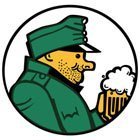

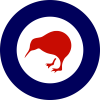

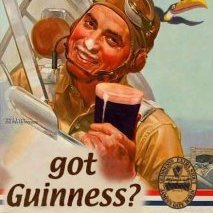
a.thumb.jpg.58d92d116b0315dc55d352fd191d65e4.jpg)
